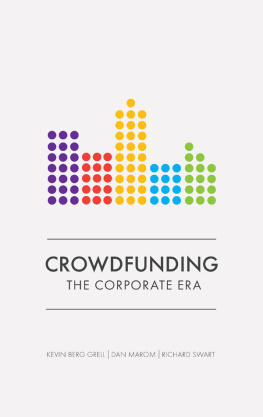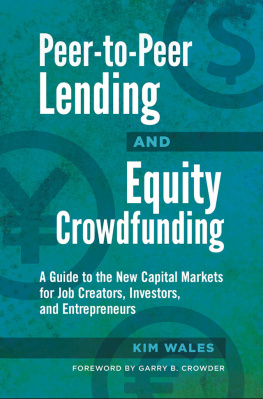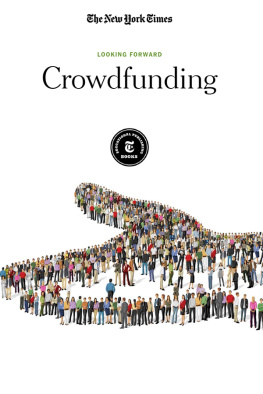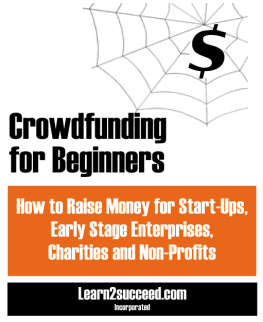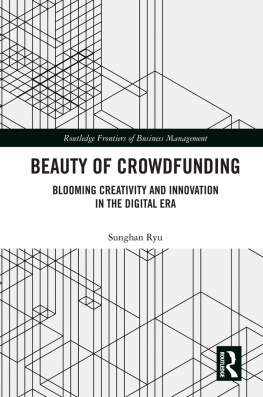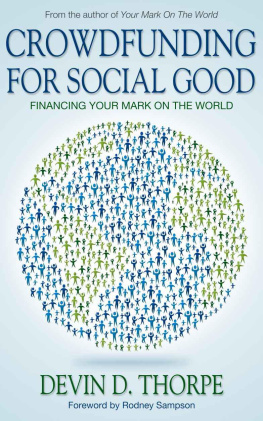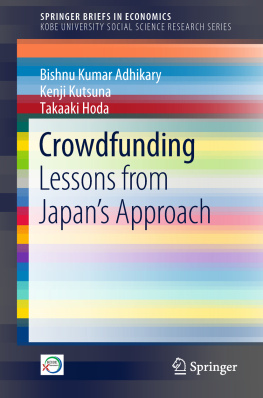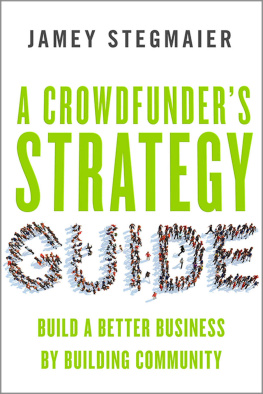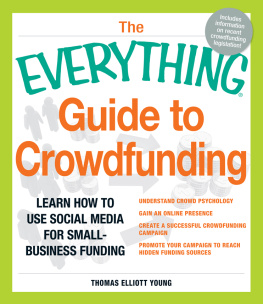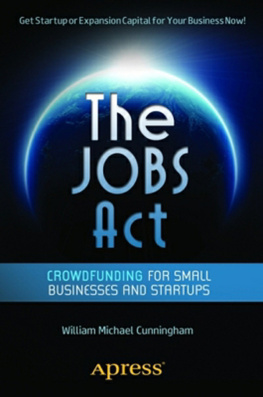By drawing from examples in corporate life, the authors show how crowd-tapping and crowd-enablement are already having significant positive impact on innovation, marketing, philanthropy, corporate social responsibility, and social enterprises. Highly recommended.
Professor Alan Barrell, Cambridge University
A rare insiders look at the cutting edge of some of the worlds top companiesand the radical new means theyre using to succeed.
Joshua Klein, author of Reputation Economics
Most now get it that crowdfunding will be huge; what this breakthrough book shows is that large companies will be a big part of it, even leading it. Get ready for the stampede as corporate giants discover the myriad benefits of unlocking the power of the crowd.
Jonathan Medved, CEO, OurCrowd
Crowdfunding and alternative finance generally is enormously disruptive and will make a huge difference to the way private businesses are funded. This book brilliantly examines why this profound transformation is so important.
David Stevenson, Executive Director AltFi and financial commentator
Crowdfunding isnt just for startups and social causes, its about customer engagement, open innovation, and market validation, things every modern company should care about.
Don Tapscott, bestselling author, most recently of The Digital Economy
Crowdfunding is coming of age and gradually moving into the mainstream. This book spotlights how corporates can leverage crowdfunding and crowdsourcing to amplify marketing, foster innovation, and enhance their CSR programmes. A pioneering and thought-provoking book!
Bryan Zhang, Crowdfunding and Alternative Finance Researcher, University of Cambridge
CONTENTS
INTRODUCTION
EMPOWERING THE CROWD
Kevin Berg Grell, Dan Marom, and Richard Swart
T he Internet will revolutionize our lives. This might sound like a decades-old slogan, but it is as true today as ever. The Internet is constantly evolving, both in technology and in functionality. Crowdfunding has been hailed as the next Internet revolution. It sprang forth in a time of need, at the end of the last decade, when investors were reticent and financing was scarce. Entrepreneurs, unable to attract a single large influx of capital from a professional investor, decided instead to raise funds in small amounts from a large group of people (the crowd); it was a way of expanding the pool of investors, while also minimizing the risk by spreading it across a multitude of donors. It also made good use of the Internets potential; campaigns could leverage the power of social media for promotion and communication, and payments could be processed quickly and simply online. It was a method first used in the creative spacefor films, plays, and musicand was then adapted for small and medium-sized enterprise finance. Now, as the phenomenon continues to grow exponentially and diversify, it is also evolvingfuelled by technological advancement, regulatory change, and the rapid adaptation of large corporations to collaborative business development.
This book is about the dawn of a new phase in crowdfundingthe era of corporate crowdfunding. When we talk about crowdfunding in this book, we are referring to initiatives where proposals and projects are shared openly, without a specific target customer or investor in mind. In this context, it becomes clear that crowdfunding is about much more than just capital. The crowd is in a sense sourced for information.
Information about public interest is the most crucial piece of information any companybig or smallcan obtain. The prospect of better channels through which to gain such information is encouraging large corporations to seek out and execute crowdfunding campaigns alongside small entrepreneurs.
Corporate crowdfunding
Corporate crowdfunding is the use of crowdfunding mechanisms by a corporate entity for the promotion, performance or improvement of one or more of its activities. Although it shares many aspects in common with crowdsourcing, it is not exactly the same thing. Crowdsourcing is the outsourcing of certain functions or activities to the crowd. Corporate crowdfunding adds a crucial layerone that is built upon small contributions that collectively make a tremendous impact. It weaves crowdsourcing, open innovation and co-creation into a holistic framework for tapping into the resources and wisdom of the crowd.
Clearly, only in rare cases are the funding volumes from crowdfunding platforms anywhere near the needs of a large corporation. When corporations venture into this space it seems clear that they have other motives for doing so. We have identified three areas where corporations can benefit from crowdfunding. These are Marketing, Innovation, and Corporate Philanthropy, which will be treated in greater detail throughout this book.
Collaboration as a norm
In 2012, an entrepreneur named Eric Migicovsky, having been turned down by several venture capital companies, decided to share his invention with the world and was rewarded with what was, up until recently, the most successful Kickstarter campaign ever, earning over $10 million. Also in 2012, another man appealed to the power of the crowd to raise over $214 million toward his goal. His name was Barack Obama. That same year, the newly inaugurated President of the United States signed into law the JOBS Act, paving the way for companies to raise funds by publicly trading equity without the need for the customary scrutiny, red tape, and regulatory due diligence. This had the crucial effect of allowing entrepreneurs to use crowdfunding platforms to issue private shares of stock to investors. Since then, crowdfunding has grown at an astounding ratefrom a handful of online platforms at the end of the last decade, to hundreds of different platforms, catering to almost every possible niche. Together they span a global industry of billions of dollars that has nearly tripled in size in the last two years alone. And, as it continues to grow, so does it evolve.
What began as an alternative mode of finance, a grassroots movement, is becoming much more. Crowdfunding, at its core, is a method of bringing people together for a common goal. As such, it is a community tool, spreading through established communities but also creating them in its wake. After all, what is a community but a bunch of people who bond over their common interests; and the Internet, in which we live so much of our lives, has provided an influx of new communities. We are no longer limited by borders and geographical distances, and we are barely limited by language and cultural differences.
Crowdfunding platforms have synergized seamlessly with this development. Every forum of environmentalists has become a potential donors pool for crowdfunded ecological projects, every message board a billboard, and every Facebook group a potential client base. But the opposite is also true. Many crowdfunding projects have also sprouted their own online communities of loyal, active, vocal members.
One of the biggest changes in how we use the Internet has been a shift towards decentralized, peer-to-peer type consumption. This movement, also dubbed the sharing economy, appears in almost every aspect of our online lives. Where we used to entertain ourselves by watching television or reading a book, we still do, but we also check in on Facebook or watch YouTube and Vine videos. Where once we relied on tabloids and newspapers for information, we still do, but now we also have direct access to millions of sources through collaborative platforms such as Twitter, Wikipedia, and the
Next page
